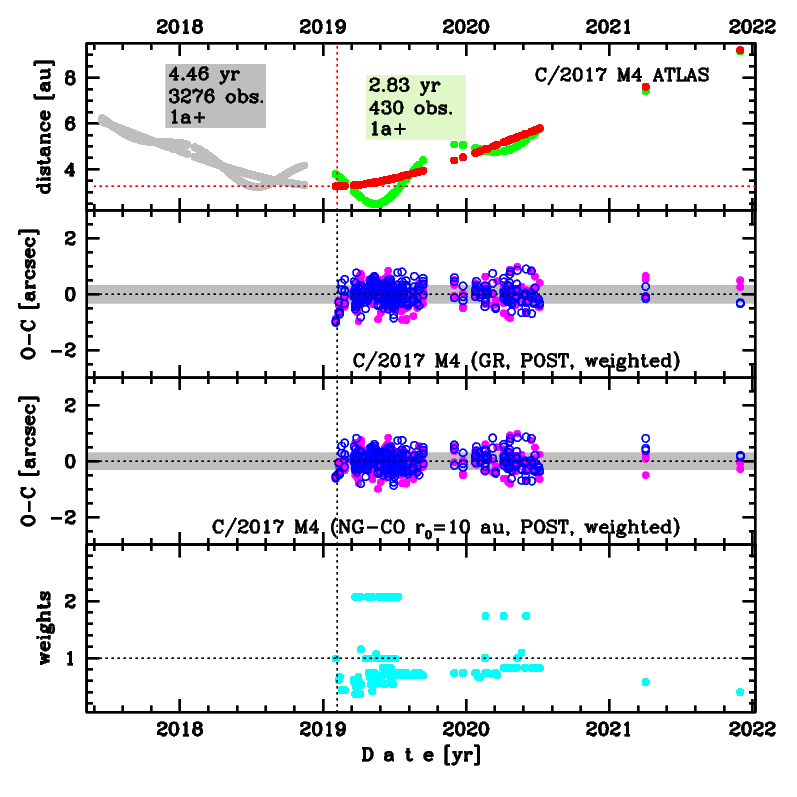C/2017 M4 ATLAS
more info
Comet C/2017 M4 was discovered on 21 June 2017 by Asteroid Terrestrial-impact Last Alert System (ATLAS) Team, that is about a year and 7 months before its perihelion passage. Some prediscovery images of this comet were found: taken on 16 June 2017 by Pan-STARRS 1 telescope (Haleakala).
Solutions given here are based on data spanning over 4.46 yr in a range of heliocentric distances: 6.09 au – 3.252 au (perihelion) – 9.19 au.
NG orbits using full data-arc as well as independently using pre-perihelion and post-perihelion data are determinable.
See also Królikowska and Dones 2023.
| solution description | ||
|---|---|---|
| number of observations | 430 | |
| data interval | 2019 02 01 – 2021 11 30 | |
| data arc selection | data generally limited to post-perihelion (POS) | |
| range of heliocentric distances | 3.25 au – 9.19au | |
| type of model of motion | NC - non-gravitational orbits for symmetric CO-g(r)-like function | |
| data weighting | YES | |
| number of residuals | 834 | |
| RMS [arcseconds] | 0.31 | |
| orbit quality class | 1a | |
| orbital elements (heliocentric ecliptic J2000) | ||
|---|---|---|
| Epoch | 2019 02 06 | |
| perihelion date | 2019 01 18.17848976 | ± 0.00167435 |
| perihelion distance [au] | 3.25175483 | ± 0.00000645 |
| eccentricity | 1.00230083 | ± 0.00001261 |
| argument of perihelion [°] | 167.619006 | ± 0.000405 |
| ascending node [°] | 65.867721 | ± 0.000026 |
| inclination [°] | 105.657509 | ± 0.000116 |
| reciprocal semi-major axis [10-6 au-1] | -707.57 | ± 3.88 |

Upper panel: Time distribution of positional observations with corresponding heliocentric (red curve) and geocentric (green curve) distance at which they were taken. The horizontal dotted line shows the perihelion distance for a given comet whereas vertical dotted line — the moment of perihelion passage.
Middle panel(s): O-C diagram for a given solution (sometimes in comparison to another solution available in CODE), where residuals in right ascension are shown using magenta dots and in declination by blue open circles.
Lowest panel: Relative weights for a given data set(s).
Middle panel(s): O-C diagram for a given solution (sometimes in comparison to another solution available in CODE), where residuals in right ascension are shown using magenta dots and in declination by blue open circles.
Lowest panel: Relative weights for a given data set(s).
| non-gravitational parameters | ||
|---|---|---|
| A1 [10-8au/day2] | 2.0982 | ± 0.2322 |
| A2 [10-8au/day2] | -0.88176 | ± 0.29757 |
| A3 [10-8au/day2] | 0.17223 | ± 0.14085 |
| m | -2.00 | |
| n | 3.000 | |
| k | -2.6000 | |
| r0 [au] | 10.000 | |
| α | 0.0100 | |